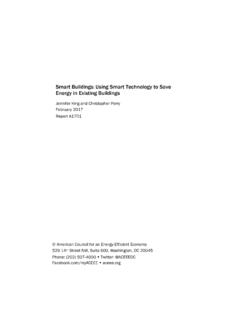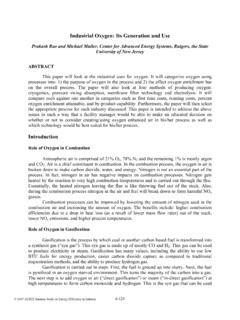Transcription of Induction Cooking Technology Design and Assessment
1 Induction Cooking Technology Design and Assessment Micah Sweeney, Jeff Dols, Brian Fortenbery, and Frank Sharp electric power Research Institute (EPRI) ABSTRACT Induction Cooking is often considered one of the most efficient Cooking technologies. With this Technology , up to 90% of the energy consumed is transferred to the food, compared to about 74% for traditional electric systems and 40% for gas. This Technology has become popular in Europe, but its adoption in the US has been less enthusiastic. Several market barriers exist for this Technology , including high first cost, the requirement of magnetic cookware, and lower perceived reliability. This paper presents findings from a technical Assessment of Induction Cooking performed by the electric power Research Institute (EPRI) for the California Energy Commission (CEC).
2 This Assessment evaluated the Cooking efficiency of Induction Technology and estimated its energy savings potential. Total cost of ownership is considered, as well as market barriers and non-energy benefits offered by Induction Cooking Technology . The findings of this study demonstrate that Induction Cooking is not always more efficient that conventional electric (resistive) Technology . The energy savings potential of Induction Cooking is found to be greatest when used with small cookware. The impact of these findings on standard test procedures is discussed, and recommendations for improvement are suggested. Finally, a prototype cooker Design is presented, with a discussion of the limitations of current designs that prevents their operation with non-magnetic cookware. Introduction Induction Cooking is often considered one of the most efficient technologies for stovetop Cooking .
3 This Technology relies on the principle of magnetic Induction , in which eddy currents are excited in a ferromagnetic cookware when in the presence of an oscillating magnetic field. These induced currents dissipate heat by the Joule effect, generating the heat for Cooking directly in the Cooking vessel. As such, less heat is lost in inefficient thermal conduction between heating element and cookware. A typical Induction cooker is composed of a switching power electronics circuit that delivers high-frequency current to a planar coil of wire embedded in the Cooking surface. The cookware is magnetically coupled to the coil by the oscillating magnetic field, analogous to the coupling between primary and secondary coils of a transformer. Current flows in the Cooking vessel due to the low resistance of the metal, with power dissipation given by I2R.
4 The resistance of the vessel is dependent on the magnetic permeability ( ) and resistivity ( ) of the cookware, as well as the frequency of excitation. To generate sufficient heat for Cooking , cookware must be used that has relatively high permeability and resistivity. Typical Induction cookers operate at switching frequency between 25 kHz and 50 kHz. In this regime, Induction cookers are only able to couple with ferromagnetic cookware, such as cast iron and some alloys of stainless steel. Thus, modern Induction Cooking Technology is not compatible with cookware made from copper, aluminum and non-magnetic alloys of stainless steel. 3709- 2014 ACEEE Summer Study on Energy Efficiency in BuildingsStandard Cooking Efficiency Test Procedures It is important to follow a standard test procedure when evaluating efficient products so that their performance can be compared with other devices in an unbiased way.
5 The primary test procedure for measuring the efficiency of consumer Cooking appliances in the is specified by the Department of Energy (DOE) (US National Archives and Records Administration 2012). In its procedure, DOE specifies the heating of a solid aluminum test block on maximum power until its temperature has increased by 144 F (80 C). At this point, power is reduced to 25% 5% of maximum and held for 15 minutes. Cooking efficiency is calculated as the ratio of thermal energy absorbed by the block divided by the energy consumed by the device as it heated the block. Because this procedure specifies that an aluminum test block be used as the Cooking load, it cannot be applied to Induction Cooking products. To address this limitation, DOE proposed an amendment to its test procedure in 2013 that would allow Induction Technology to be tested alongside conventional Cooking technologies.
6 The proposal specifies that a hybrid test block composed of two pieces be used in place of the aluminum test block. The body of the test block would remain aluminum, but the aluminum block would fit inside of a base made of ferromagnetic stainless steel. This two-piece block would be used in testing all Cooking technologies, including conventional electric and gas. Apart from DOE s test procedure, two test procedures used by the food service industry provide an alternate method for evaluation the efficiency of Cooking appliances. One of these test procedures is specified by the American Society for Testing and Materials (ASTM) in its standard F1521, which is applicable to both gas and electric ranges and cooktops (ASTM 2012). The Cooking efficiency component of this test procedure calls for the heating of 20 pounds ( kg) of water in a 13 (33 cm) aluminum stock pot.
7 The water is heated from 70 to 200 F (21 to 93 C), with efficiency calculated as the change in thermal energy of the water divided by the energy consumption of the device. The ASTM test procedure is very similar to that specified by the American National Standards Institute (ANSI) standard for food service equipment, specifically gas ranges and broilers (FSTC 2003). The primary difference between the two is that ANSI specifies aluminum stock pots of different sizes to be used based on the size of the burner tested. Namely, ANSI specifies a stock pot be used with burners less than 15,000 Btu/h, a 13 pot for burners between 15,000 and 25,999 Btu/h, and 16 for burners greater than 26,000 Btu/h. Water load is specified as 4 deep, which leads to weights of approximately 10 pounds ( kg), 19 pounds ( kg), and 29 pounds ( kg), respectively.
8 For reference, residential Cooking appliances are not typically equipped with burners rated at more than 18,000 Btu/h. Table 1. Equivalent power of electric heating element for typical gas burner heat rates. Typical Gas Burner Heat Rate (Btu/h) Equivalent electric Element power (W) Small 5,000 800 Medium 9,000 1,400 Large 12,000 1,900 Extra-Large 15,000 2,400 Commercial ( Pro-sumer ) 18,000 2,900 3719- 2014 ACEEE Summer Study on Energy Efficiency in Buildings The rated power of natural gas-fueled appliances is specified by heat rate in terms of British thermal units per hour, or Btu/h, rather than kW.
9 This is a measure of the chemical energy of the gas consumed per hour and cannot directly be converted to kW due to the efficiency of combustion of the fuel. Table 1 approximates the equivalent electric power for typical gas heat rates (assuming 40% and 74% efficiency, respectively, reported by DOE [LBNL 1998]). Laboratory Testing by EPRI Because each of the major Cooking efficiency test procedures used in the specifies an aluminum stock pot be used for testing, no standard test procedure is compatible. Yet vendors often claim Cooking efficiency as high as 90%. With few third-party evaluations of Induction Cooking available, EPRI undertook a technical evaluation of Induction Cooking Technology , including laboratory testing of Induction side-by-side with conventional technologies.
10 This work was performed for the California Energy Commission (CEC) with funding provided under its Public Interest Energy Research (PIER) program. To evaluate the Cooking efficiency of Induction Cooking Technology , EPRI developed a test procedure that was compatible with the Technology and representative of actual Cooking performance. Based on ASTM F1521 and ANSI , the procedure developed by EPRI calls for 10 pounds ( kg) of water to be heated from 70 to 200 F (21 to 93 C) in a (24 cm) stainless steel stock pot. Cooking efficiency is calculated as the amount of energy delivered to the water divided by the total energy consumption by the appliance. For a direct comparison of Cooking technologies in the laboratory, EPRI selected two low-cost, standalone (countertop) Induction Cooking products for evaluation.






